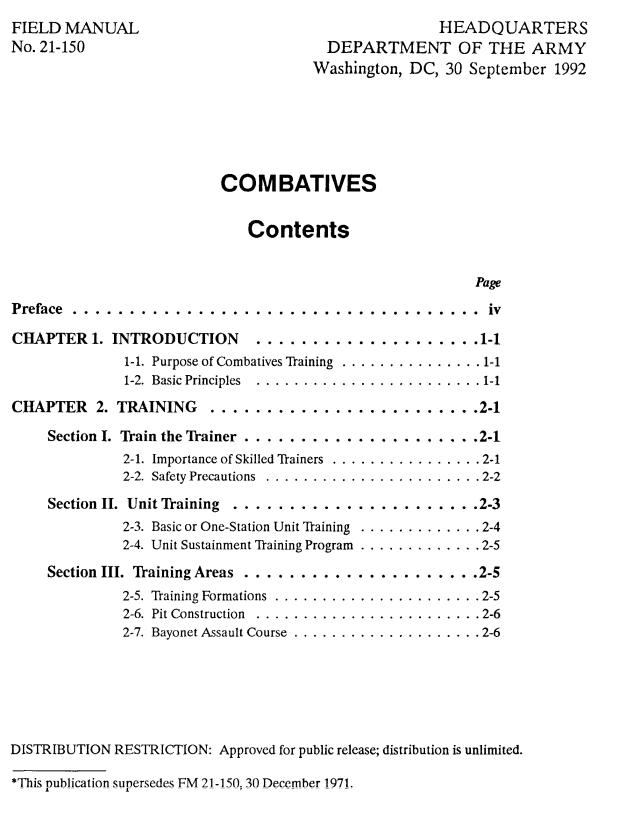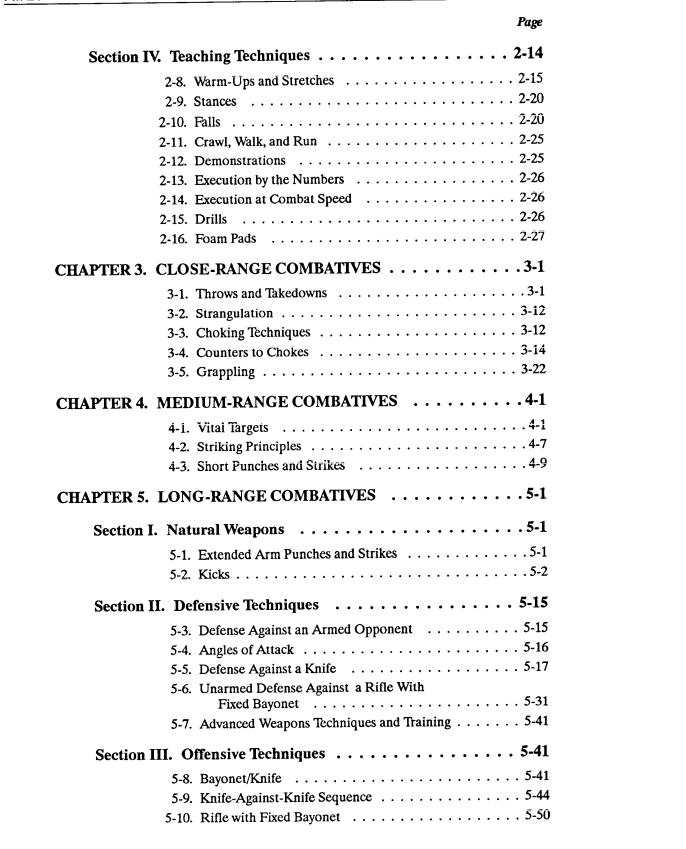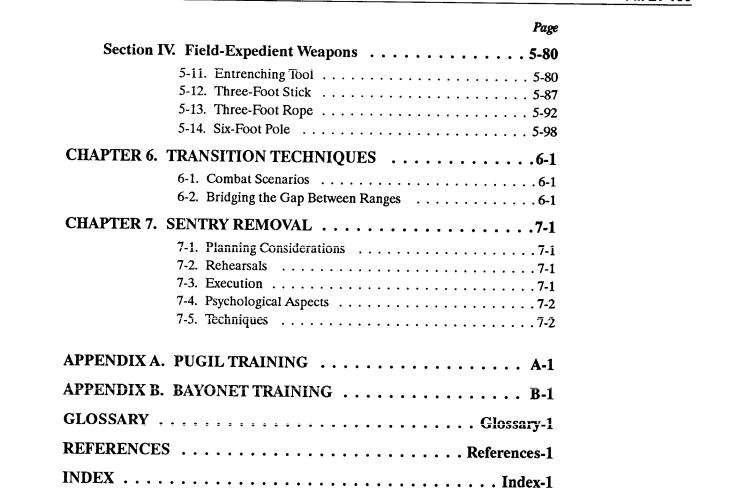
FM 21-150 COMBATIVES 1992
.pdf
*FM 21-150
i

FM 21-150
ii

FM 21-150
iii

FM 21-150
Preface
This field manual contains information and guidance pertaining to rifle-bayonet fighting and hand-to-hand combat. The hand-to-hand combat portion of this manual is divided into basic and advanced training. The techniques are applied as intuitive patterns of natural movement but are initially studied according to range. Therefore, the basic principles for fighting in each range are discussed. However, for ease of learning they are studied in reverse order as they would be encountered in a combat engagement. This manual serves as a guide for instructors, trainers, and soldiers in the art of instinctive rifle-bayonet fighting.
The proponent for this publication is the United States Army Infantry School. Comments and recommendations must be submitted on DA Form 2028 (Recommended Changes to Publications and Blank Forms) directly to Commandant, United States Army Infantry School, ATTN: ATSH-RB, Fort Benning, GA, 31905-5430.
Unless this publication states otherwise, masculine nouns and pronouns do not refer exclusively to men.
iv
CHAPTER 1
INTRODUCTION
Hand-to-hand combat is an engagement between two or more persons in an empty-handed struggle or with handheld weapons such as knives, sticks, and rifles with bayonets. These fighting arts are essential military skills. Projectile weapons may be lost or broken, or they may fail to fire. When friendly and enemy forces become so intermingled that firearms and grenades are not practical, hand-to-hand combat skills become vital assets.
1-1. PURPOSE OF COMBATIVES TRAINING
Today’s battlefield scenarios may require silent elimination of the enemy. Unarmed combat and expedient-weapons training should not be limited to forward units. With rapid mechanized/motorized, airborne, and air assault abilities, units throughout the battle area could be faced with close-quarter or unarmed fighting situations. With low-intensity conflict scenarios and guerrilla warfare conditions, any soldier is apt to face an unarmed confrontation with the enemy, and hand-to-hand combative training can save lives. The many practical battlefield benefits of combative training are not its only advantage. It can also—
a.Contribute to individual and unit strength, flexibility, balance, and cardiorespiratory fitness.
b.Build courage, confidence, self-discipline, and esprit de corps.
1-2. BASIC PRINCIPLES
There are basic principles that the hand-to-hand fighter must know and apply to successfully defeat an opponent. The principles mentioned are only a few of the basic guidelines that are essential knowledge for hand-to-hand combat. There are many others, which through years of study become intuitive to a highly skilled fighter.
a. Physical Balance. Balance refers to the ability to maintain equilibrium and to remain in a stable, upright position. A hand-to-hand fighter must maintain his balance both to defend himself and to launch an effective attack.
1-1

FM 21-150
Without balance, the fighter has no stability with which to defend himself, nor does he have a base of power for an attack. The fighter must understand two aspects of balance in a struggle:
(1)How to move his body to keep or regain his own balance. A fighter develops balance through experience, but usually he keeps his feet about shoulder-width apart and his knees flexed. He lowers his center of gravity to increase stability.
(2)How to exploit weaknesses in his opponent's balance. Experience also gives the hand-to-hand fighter a sense of how to move his body in a fight to
maintain his balance while exposing the enemy’s weak points.
b.Mental Balance. The successful fighter must also maintain a mental balance. He must not allow fear or anger to overcome his ability to concentrate or to react instinctively in hand-to-hand combat.
c.Position. Position refers to the location of the fighter (defender) in relation to his opponent. A vital principle when being attacked is for the defender to move his body to a safe position—that is, where the attack cannot
continue unless the enemy moves his whole body. To position for a counterattack, a fighter should move his whole body off the opponent’s line of attack. Then, the opponent has to change his position to continue the attack. It is usually safe to move off the line of attack at a 45-degree angle, either toward the opponent or away from him, whichever is appropriate. This position affords the fighter safety and allows him to exploit weaknesses in the enemy’s counterattack position. Movement to an advantageous position requires accurate timing and distance perception.
d.Timing. A fighter must be able to perceive the best time to move to an advantageous position in an attack. If he moves too soon, the enemy will anticipate his movement and adjust the attack. If the fighter moves too late, the enemy will strike him. Similarly, the fighter must launch his attack or counterattack at the critical instant when the opponent is the most vulnerable.
e.Distance. Distance is the relative distance between the positions of opponents. A fighter positions himself where distance is to his advantage. The hand-to-hand fighter must adjust his distance by changing position and developing attacks or counterattacks. He does this according to the range at which he and his opponent are engaged. (For a more detailed discussion of the concepts of distance and range, see Chapter 6.)
f.Momentum. Momentum is the tendency of a body in motion to continue in the direction of motion unless acted on by another force. Body mass in motion develops momentum. The greater the body mass or speed of movement, the greater the momentum. Therefore, a fighter must understand the effects of this principle and apply it to his advantage.
1-2

FM 21-120
(1) The fighter can use his opponent’s momentum to his advantage—that is, he can place the opponent in a vulnerable position by using his momentum against him.
(a)The opponent’s balance can be taken away by using his own momentum.
(b)The opponent can be forced to extend farther than he expected, causing him to stop and change his direction of motion to continue his attack.
(c)An opponent’s momentum can be used to add power to a fighter’s own attack or counterattack by combining body masses in motion.
(2)The fighter must be aware that the enemy can also take advantage of the principle of momentum. Therefore, the fighter must avoid placing himself in an awkward or vulnerable position, and he must not allow himself to extend too far.
g. Leverage. A fighter uses leverage in hand-to-hand combat by using the natural movement of his body to place his opponent in a position of unnatural movement. The fighter uses his body or parts of his body to create a natural mechanical advantage over parts of the enemy’s body. He should never oppose the enemy in a direct test of strength; however, by using leverage, he can defeat a larger or stronger opponent.
1-3
CHAPTER 2
TRAINING
This chapter discusses the trainer’s role in teaching and sustaining effective hand-to-hand combat. It also discusses unit training training areas, teaching techniques, and safety precautions that must be considered before conducting combatives training.
Section I
TRAIN THE TRAINER
Professional instruction is the key to success in combative training. Instructors must be physically fit and highly proficient in the demonstration and practical application of the skills described in this manual. Confidence, enthusiasm, and technical expertise are essential for success in teaching hand-to-hand combat. Assistant instructors must also be properly trained to help supervise and demonstrate maneuvers. Highly trained assistant instructors under supervision may also provide supplementary combative training during off-duty hours.
2-1. IMPORTANCE OF SKILLED TRAINERS
Diligent effort is needed to perfect the various hand-to-hand combat techniques, to apply them instinctively, and to teach others to safely master them. The following instructor responsibilities are the core of planning and executing combative training.
a.Seek maximum efficiency with minimum effort. Continually strive to reduce all unnecessary explanations, movement, and activity. Streamline the training without compromising content, efficiency, or safety.
b.Stress cooperation and technical mastery. Minimize hostile behavior but promote aggressiveness and power.
c.Reinforce the details of each technique, and provide positive feedback when warranted. Use occasional humor to motivate soldiers, but avoid degrading or insulting them.
2-1

FM 21-150
d.Ensure serviceable training aids are present to use in sufficient quantities for all soldiers being trained. Ensure training areas are well maintained and free from dangerous obstructions.
e.Ensure instructors and assistant instructors are well rehearsed and prepared before all training sessions. Conduct instructor training at least five hours weekly to maintain a high skill level.
f.Develop as many skilled combative instructors for each unit as possible. Instructor-to-soldier ratios should not be less than 1 instructor for 20 soldiers. Encourage after-duty training and education for instructors.
g.Require strict discipline of all soldiers.
2-2. SAFETY PRECAUTIONS
To prevent injuries, the instructor must consider the following safety
precautions before conducting combative training.
a.Supervise all practical work closely and constantly. Never leave a group unsupervised.
b.Familiarize the soldiers with each maneuver by a complete explanation and demonstration before they try the moves.
c.Do not allow the soldiers to get ahead of the instruction.
d.Ensure the training partner offers no resistance, but allows the maneuver to be freely executed during the learning stages and while perfecting the techniques.
e.Ensure there is adequate space between soldiers during all practical work—for example, allow at least an 8-foot square for each pair of soldiers.
f.Ensure that soldiers empty their pockets, and remove their jewelry, identification tags, and glasses before training.
g.Stress that only simulated strikes to vital points, such as the head, neck, and groin area, are executed. Soldiers may use light blows to other vulnerable areas; however, they must exercise caution at all times.
h. Establish a signal to indicate to the partner when to stop the pressure
in grappling and choking techniques. Two handclaps or tapping the training
partner with a free hand are examples.
i.Make sure soldiers warmup and stretch properly before practical work.
j.Teach and practice falls before conducting throws.
k.Ensure protective eye wear is available when executing training with practice bayonets, knives, or any sharp weapons.
l.Ensure that the soldier to be disarmed does not place his finger in the trigger guard during rifle and bayonet disarming.
m.Make sure soldiers keep scabbards on knives and bayonets firmly attached to rifles while learning bayonet disarming methods.
n.Use bayonet scabbards or rubber knives during knife disarming training.
2-2

FM 21-150
0. Inspect all sandbags on retaining walls before conduct of instruction so that all bags are serviceable with at least 75 percent fill and that entire retainer wall is covered with sandbags. Any bag placed where personnel are likely to fall will be filled with the same consistency filler as the sawdust in the pit and will also provide a minimum of 6 inches of sawdust.
p.Maintain a buffer zone of 6 feet from retainer wall and demonstration area during all training, especially training requiring throws and takedowns by students.
q.Rake the training pit to loosen sawdust and remove all sharp objects. Properly inspect the pit so that all safety hazards are removed before instruction/demonstrations are executed.
r.Perform inspections on training pits two days before use to ensure that there is at least 6 inches of sawdust throughout the training pit area. This will allow time to acquire sawdust to resurface pit area if there is not 6 inches of surface sawdust.
Section II
UNIT TRAINING
Although combative are not likely to become part of a unit’s mission-essential task list, commanders cannot overlook the importance of soldiers’ skills in hand-to-hand combat. Hand-to-hand fighting is a possibility in any conflict, and a basic proficiency in combative may save soldiers’ lives. Entry-level soldiers receive a training base in combative during basic training and in OSUT. Advanced individual training commanders should consider using hand-to-hand combat as part of the physical training program. They should review the training presented during basic training and, as time permits, expand into the more advanced techniques discussed in this field manual. Regular units must incorporate combative into an organized training program for soldiers to achieve and sustain proficiency levels.
CAUTION
WHEN PLANNING COMBATIVES TRAINING,
INSTRUCTORS MUST TAKE PRECAUTIONS ACCORDING
TO THE TIME OF DAY SEASON, AND ACCLIMATIZATION
OF SOLDIERS. THEY MUST ALSO CONSIDER
MODIFICATION OF THE UNIFORM, BREAK TIMES, AND OR
THE AVAILABILITY OF WATER.
2-3
